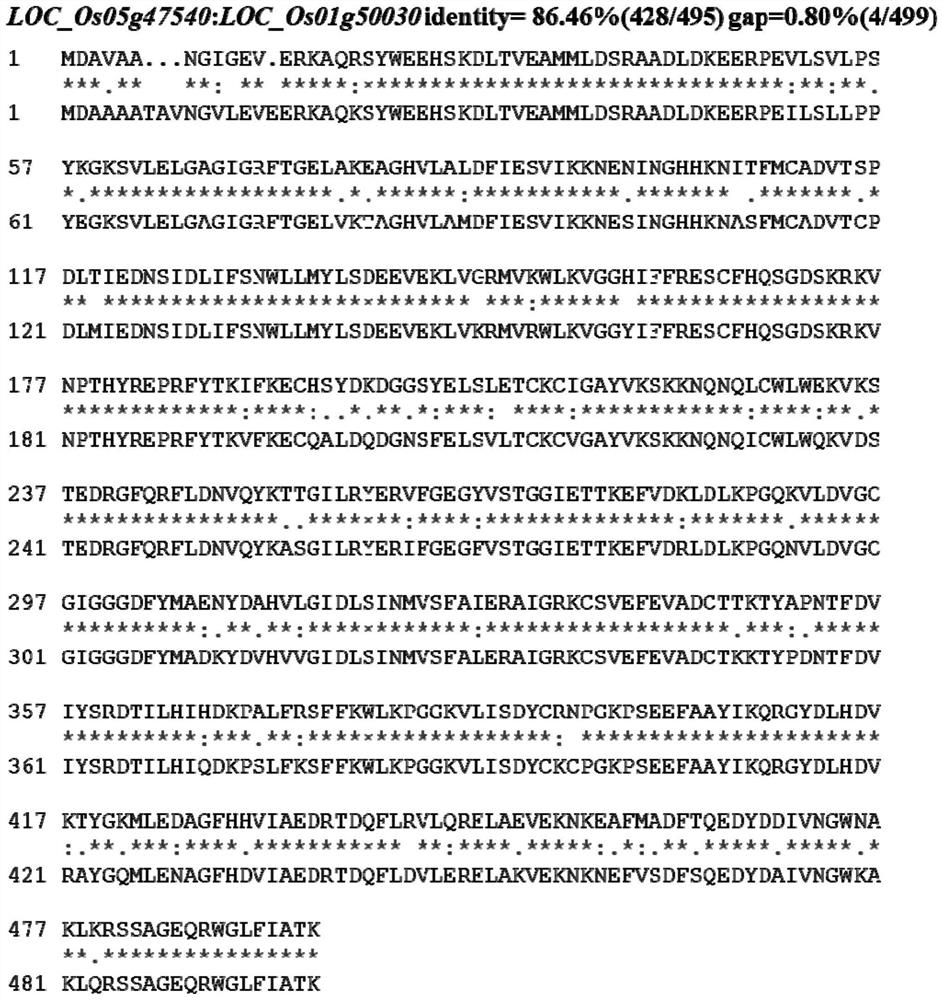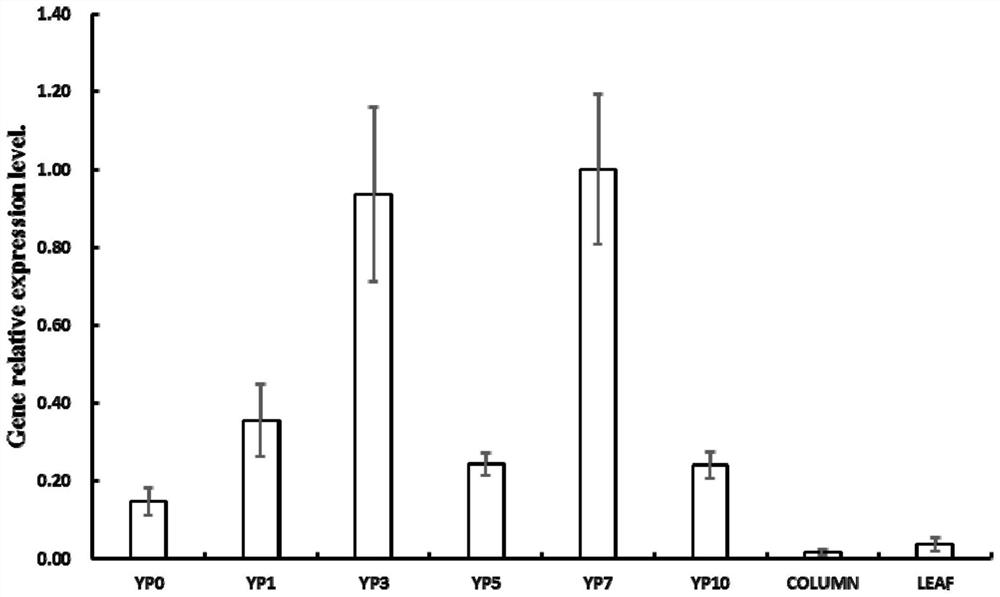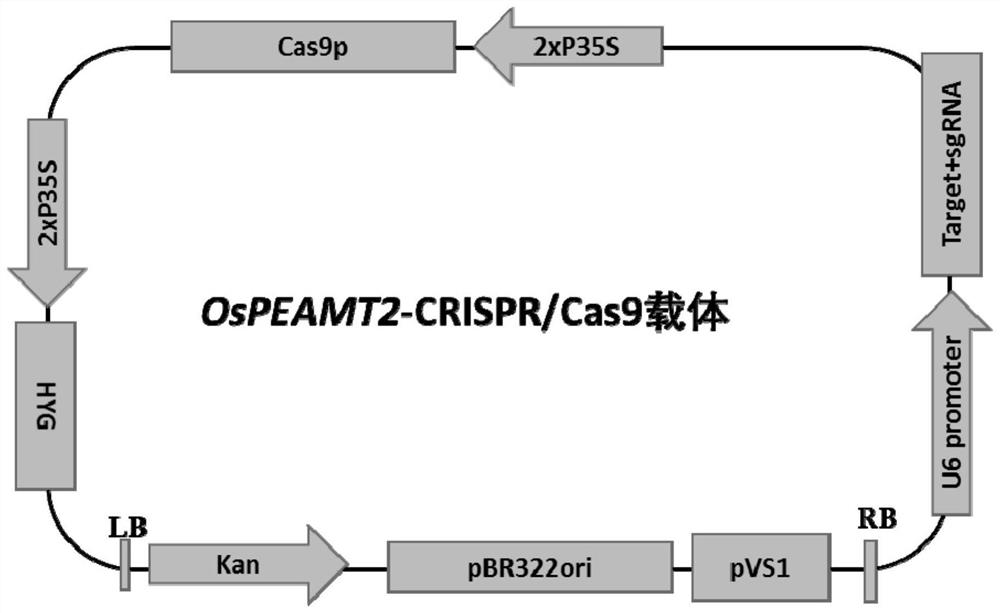A kind of ospeamt2 gene, its protein and its application to improve the rice seed-setting rate at heading stage under high temperature stress
A technology of high temperature stress and heading time, applied in the field of genetic engineering, can solve the problems of lagging rice research and difficulties in high temperature research
- Summary
- Abstract
- Description
- Claims
- Application Information
AI Technical Summary
Problems solved by technology
Method used
Image
Examples
Embodiment 1
[0026] Example 1 Homologous Alignment Analysis of PEAMT Family Protein Sequences in Rice
[0027] 1. Homologous gene sequence acquisition
[0028] The protein sequence of rice is from the Rice Genome Annotation Project (http: / / rice.plantbiology.msu.edu). The codes of the obtained protein sequences are as follows: OsPEAMT1 (LOC_Os01g50030), OsPEAMT2 (LOC_Os05g47540).
[0029] 2. Creation of evolutionary tree
[0030] Using DNAMAN7, the protein sequences of OsPEAMT1 and OsPEAMT2 were loaded into different lanes, and then the protein homology was analyzed by double-sequence alignment. The sequence analysis results are as figure 1 As shown, there are two PEAMT genes in rice, which are named OsPEAMT1 and OsPEAMT2 respectively. The data show that the homology of the two genes is as high as 86.46%. This application conducts research on OsPEAMT2, and explores the biological function of this type of gene in rice by designing a knockout experiment.
[0031] 3. Expression profiling ...
Embodiment 2
[0036] Example 2 OsPEAMT2 gene editing vector construction
[0037] 1. Gene editing site design
[0038] In this study, according to the existing CRISPR / Cas9-related experimental methods, ACTAATGTACCTTTCAGATGAGG, which contains AGG as the recognition site, was selected on the fifth exon of OsPEAMT2 as the knockout target site of OsPEAMT2 ( image 3 , Figure 4 ), it is expected to obtain a loss-of-function transgenic plant to clarify the biological function of the OsPEAMT2 gene.
[0039] 2. CRISPR / Cas9 vector construction
[0040] Take 5 μL of 10 μM primers before and after the target site, mix them, anneal at 99 °C for 5 min, and cool naturally to obtain a double-stranded sequence containing the knockout target site, then use Bas1 (NEB company) to digest and ligate (37 °C), and target site The dot sequence was connected to the intermediate vector pYLsgRNA-OsU6a, and then the universal amplification primers CTCCGTTTTACCTGTGGAATCG (UF) and CGGAGGAAAATTCCATCCAC (gR-R) were us...
Embodiment 3
[0047] Example 3 OsPEAMT2 gene editing under the background of Nihonbare
[0048] 1. Detection of transgenic seedlings
[0049] A total of 10 seedlings were obtained by Agrobacterium infection and transformation. First, the G418 detection primer was used to detect the transformation of the vector, and then the sequence in the positive individual plants was amplified with the amplification primers U1028 (TTCTGTAGAATGAGAACAT) + U1029 (ACTAGCTTCTCGACCTACAGTA) across the target site. Sent to Qingke Sequencing Company for sequencing, the results are as follows Figure 4 As shown, the comparison analysis of the obtained sequences showed that the transgenic plant ospeamt2, which was prematurely terminated in protein translation, was co-acquired.
[0050] 2. Phenotype Analysis
[0051] In the T1 generation planting, different lines were divided into 3 repeated plantings in field experiments, and 2 rows were planted for each repeated planting. First, the presence of stable mutations ...
PUM
 Login to View More
Login to View More Abstract
Description
Claims
Application Information
 Login to View More
Login to View More - R&D
- Intellectual Property
- Life Sciences
- Materials
- Tech Scout
- Unparalleled Data Quality
- Higher Quality Content
- 60% Fewer Hallucinations
Browse by: Latest US Patents, China's latest patents, Technical Efficacy Thesaurus, Application Domain, Technology Topic, Popular Technical Reports.
© 2025 PatSnap. All rights reserved.Legal|Privacy policy|Modern Slavery Act Transparency Statement|Sitemap|About US| Contact US: help@patsnap.com



